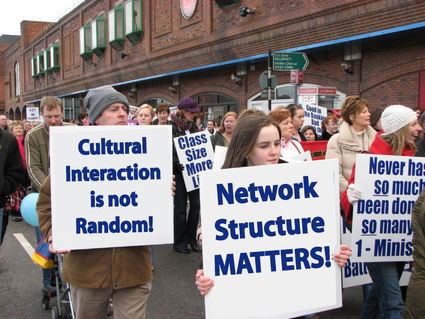An Abstract Model Showing that the Spatial Structure of Social Networks Affects the Outcomes of Cultural Transmission Processes (2013, Journal of Artificial Societies and Social Simulation 16(3) 9)
|
This was one of those papers that took way too long to get done. I first started working on it in 2009 or 2010 as I was learning the ropes of computer modeling and busily creating models that were much simpler than the one that I would eventually use in my dissertation. I was reading some papers on cultural transmission theory (CTT) and found that I had two reactions: 1) I really liked the simplicity of the basic idea that patterns of variability in material culture have an origin that is understandable and useful for understanding the past; 2) I was really unimpressed by equation-heavy papers that were interpreting variability in material culture as the result of one of a pretty narrow spectrum of "transmission" systems.
Maybe there is a beauty to the mathematics in these CTT papers that is appealing to some people. Maybe I'm just not getting it. I'm a lousy mathematician, so I tried to understand the papers conceptually. I felt like most of the papers that I read did not consider one of the most basic things that affects processes of social learning in most societies that archaeologists study: spatially-structured interaction. While I'm a lousy mathematician, I was getting better at representing things in models. One of the great things about agent-based models is that they are perfect for putting something in space (something that equations can't do, as far as I know). So I decided to embed a representation of a simple cultural transmission process into one of my simple models and see what effects spatially-structured interaction had on the patterns of variability that were produced. I found that the spatial structure of interaction did make a difference. A significant difference. The take-away point I tried to convey was not that CTT was inherently wrong, but that equation-based models of cultural transmission that ignored space were doing so at their own peril. Space matters.
I finished the paper and thought it was a good one. I submitted it to what I thought was an appropriate journal. I received some pretty serious criticisms (points "a" through "u") from one of the reviewers, and had to put the manuscript aside for a time to focus on making progress on the dissertation. Eventually I got around to the revisions, and I put serious effort into trying to satisfy the reviewer. His/her response to my revisions was "I give up." And so the editor booted the paper from Journal #1. I picked the Journal of Artificial Societies and Social Simulation as Journal #2. This was a much better choice, which a much better outcome. JASSS accepted the paper with minor revisions. The three reviews were positive. One said "this paper introduces novel network structures and a useful context. As such it provides a key foundation for work which is plainly going somewhere interesting and is to be supported on this basis." Thank you, Referee 2, for getting it. That paper was in JASSS's "Most Viewed" list for some time after publication, which was very gratifying. The publication is available here. I hope to revisit the ideas in the paper at some point with a more detailed generation of models and see if the results are the same. As applied these days, CTT has both baby and bathwater. To me, the non-spatial equations are the bathwater. They are both insufficient and analytically unnecessary. |
